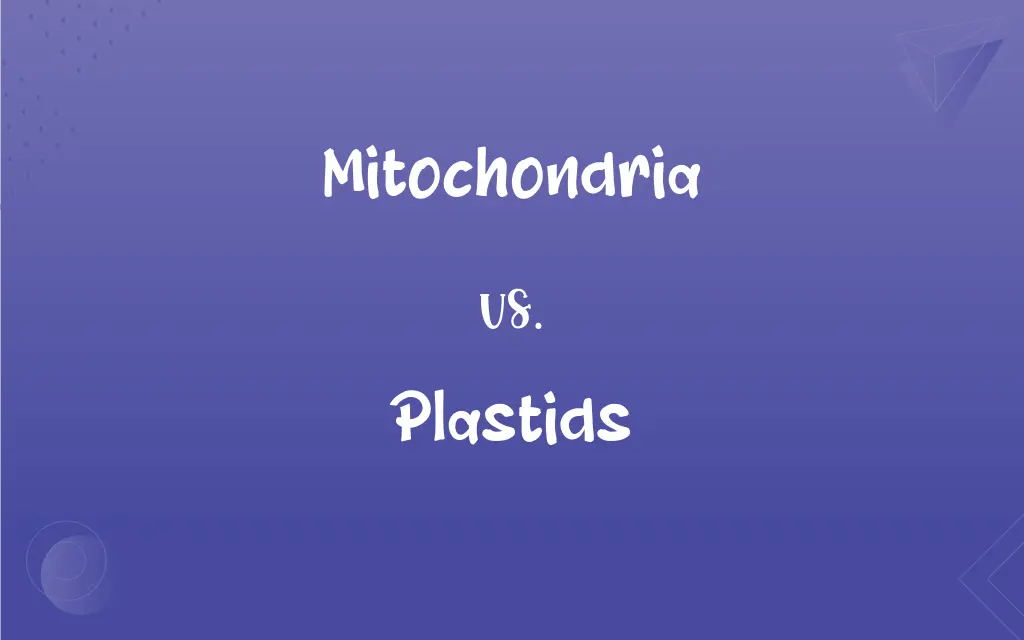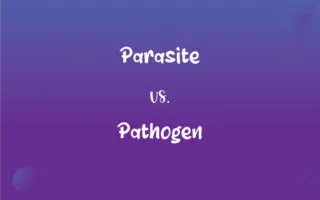Mitochondria vs. Plastids: What's the Difference?
Edited by Janet White || By Harlon Moss || Updated on October 28, 2023
Mitochondria produce energy for cells; plastids are involved in synthesis and storage in plant cells.

Key Differences
Mitochondria are organelles found in nearly all eukaryotic cells, responsible for producing adenosine triphosphate (ATP), the cell's main energy currency. Plastids, on the other hand, are found exclusively in plant cells and certain algae, playing roles in synthesis and storage.
Mitochondria have a double-membrane structure, with an inner and outer membrane, facilitating various metabolic processes. Plastids come in multiple forms, such as chloroplasts (for photosynthesis), chromoplasts (for pigment synthesis and storage), and leucoplasts (for synthesis and storage of molecules like starch).
Both mitochondria and plastids are believed to have originated from ancient symbiotic bacteria through a process called endosymbiosis. However, while mitochondria are prevalent in almost all eukaryotes, plastids remain specific to plants and certain algal species.
Comparison Chart
Function
Produce energy (ATP).
Synthesis and storage in plant cells.
Location
All eukaryotic cells.
Plant cells and certain algae.
ADVERTISEMENT
Structure
Double-membraned.
Varying structures (e.g., chloroplasts).
Origin
From ancient symbiotic bacteria.
From ancient cyanobacteria.
Types
One main type.
Multiple types (chloroplasts, chromoplasts, leucoplasts).
Mitochondria and Plastids Definitions
Mitochondria
Powerhouses of the cell.
Without mitochondria, cells would lack energy.
Plastids
Involved in synthesis and storage.
Starches are stored in certain plastids called amyloplasts.
ADVERTISEMENT
Mitochondria
Organelles that generate energy.
Cells rely on mitochondria for their energy needs.
Plastids
Sites for photosynthesis in plants.
Chloroplasts, a type of plastid, contain chlorophyll for photosynthesis.
Mitochondria
Sites of cellular respiration.
Oxygen is utilized by mitochondria to produce ATP.
Plastids
Originated from ancient cyanobacteria.
Plastids share similarities with cyanobacteria, indicating a shared ancestry.
Mitochondria
Originated from ancient bacteria.
The theory of endosymbiosis explains the origin of mitochondria.
Plastids
Have diverse forms and functions.
Chromoplasts are plastids that store pigments in plants.
Mitochondria
Double-membraned organelles.
The unique structure of mitochondria facilitates its function.
Plastids
Organelles found in plant cells.
Plastids play vital roles in photosynthesis and storage.
Mitochondria
A spherical or elongated organelle in the cytoplasm of nearly all eukaryotic cells, conning genetic material and many enzymes important for cell metabolism, including those responsible for the conversion of food to usable energy.
Plastids
Any of several cytoplasmic organelles, such as chloroplasts, that contain genetic material, have a double membrane, and are often pigmented. Plastids are found in plants, algae, and certain other eukaryotic organisms and have various physiological functions, such as the synthesis and storage of food.
Mitochondria
Plural of mitochondrion
Muscles contain many mitochondria so that they can have large energy supplies.
Plastids
Plural of plastid
FAQs
What is the primary function of mitochondria?
Mitochondria produce ATP, the main energy currency of cells.
Are plastids present in animal cells?
No, plastids are exclusive to plant cells and some algae.
Why are mitochondria called the powerhouse of the cell?
Because they generate most of the cell's energy through ATP production.
Are there different types of mitochondria?
Mitochondria are generally uniform in function but can vary in shape and number.
Do all cells contain mitochondria?
Nearly all eukaryotic cells contain mitochondria, with few exceptions.
How do mitochondria produce energy?
Through a process called cellular respiration, using oxygen to produce ATP.
What's the significance of mitochondria in health and disease?
Mitochondrial dysfunction can lead to various diseases, including some neurological disorders.
What is the role of chloroplasts?
Chloroplasts, a type of plastid, are involved in photosynthesis in plants.
Are plastids and chloroplasts the same?
Chloroplasts are a type of plastid specifically involved in photosynthesis.
Do mitochondria have their own DNA?
Yes, mitochondria have their own circular DNA, separate from the cell's nucleus.
What do leucoplasts store?
Leucoplasts, a type of plastid, store molecules like starches and oils.
How did mitochondria evolve?
They are believed to have originated from ancient symbiotic bacteria via endosymbiosis.
Where are plastids located in a cell?
Plastids are found in the cytoplasm of plant cells.
Do plastids have their own DNA?
Yes, plastids also have their own circular DNA.
What do chromoplasts store?
Chromoplasts, a type of plastid, store pigments in plants.
What's the significance of the double membrane in mitochondria?
It aids in compartmentalization and efficient energy production.
How are plastids essential for plant survival?
Plastids play roles in photosynthesis, storage, and pigment synthesis, crucial for growth and reproduction.
How are mitochondria inherited?
Mitochondria are typically inherited maternally, passed from mother to offspring.
How many types of plastids exist?
There are multiple types, including chloroplasts, chromoplasts, and leucoplasts.
Can plastids change their type?
Yes, plastids can differentiate into other types based on the cell's needs.
About Author
Written by
Harlon MossHarlon is a seasoned quality moderator and accomplished content writer for Difference Wiki. An alumnus of the prestigious University of California, he earned his degree in Computer Science. Leveraging his academic background, Harlon brings a meticulous and informed perspective to his work, ensuring content accuracy and excellence.
Edited by
Janet WhiteJanet White has been an esteemed writer and blogger for Difference Wiki. Holding a Master's degree in Science and Medical Journalism from the prestigious Boston University, she has consistently demonstrated her expertise and passion for her field. When she's not immersed in her work, Janet relishes her time exercising, delving into a good book, and cherishing moments with friends and family.
































































